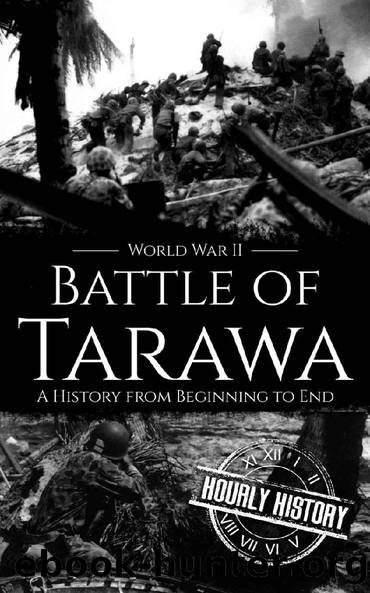Battle of Tarawa - World War II: A History from Beginning to End (World War 2 Battles Book 14) by Hourly History

Author:Hourly History [History, Hourly]
Language: eng
Format: epub
Published: 2019-11-08T00:00:00+00:00
Chapter Four
Eyewitness to the Betio Landing
âThose who were not hit would always remember how the machine gun bullets hissed into the water, inches to the right, inches to the left.â
âRobert Sherrod, Time
Robert Sherrod was an experienced war correspondent who had covered the U.S. Army campaigns in the Aleutian Islands and the Navyâs Wake Island campaign. Despite his veteran status as a war correspondent, the bloody battle for Tarawa left its mark upon him, and he wrote a book in 1944, detailing his experiences. His writing skill, journalistic powers of observation, and candor left no doubt that the Marines had performed heroically in the battle.
Robert Sherrod was with Marines aboard the Blue Fox, a Navy transport, early on the morning of November 20, waiting for orders to board a landing craft. When he heard a noise coming from the southwest at 5:05 am, he and the soldiers knew that the first battleship had fired the first shot and the battle was underway. Within three minutes, Sherrod saw the sky fill with the flash of the gun and the red ball of fire that signaled the high-explosive shell was dropping toward the horizon. A wall of flame flew 500 feet into the air and another explosion proved that the sour shells, each weighing over a ton, had hit Betio, setting the island aglow from the fires that the bombardment had ignited. Another battleship began to fire on a different section of the island, then a heavy cruiser fired its eight-inch guns, and light cruisers did the same with six-inch guns. The destroyers, many with five-inch guns, began firing nearly as fast as machine guns. The sky, Sherrod wrote, was brighter than noontime on the equator. As each blast hit the island, the Marines cheered.
Suddenly, the firing from the warships ceased. Then the planes came, a hundred of them as the first torpedo bombers dropped their bombs on Betio, an island, Sherrod wrote, âthat must have been dead a half hour ago!â The dive bombers lined up thousands of feet over Betio, pointed their noses down, and dove singly, in pairs, and in trios. The bombs fell and the planes went back to the carriers for more. They were followed by the new, fast Grumman Hellcat fighter planes, which discharged hundreds of fifty-caliber bullets a minute. After such an attack, Sherrod did not see how any Japanese could still be alive on the island. He was about to find out.
At 6:35 am, Sherrod and the Marine assault force with which he was embedded boarded a Higgins boat. The landing craft took ninety minutes to reach its point of rendezvous off the beach. There, it joined the other assault boats for the landing. But there werenât any landing crafts on the beach. By this time, four assault waves should already have gone ashore, but the landing craft commander could not go any further because the water was too shallow. The assault team learned that it would have to transfer to an amtrac to reach the shore.
Download
This site does not store any files on its server. We only index and link to content provided by other sites. Please contact the content providers to delete copyright contents if any and email us, we'll remove relevant links or contents immediately.
The Light of Days by Judy Batalion(836)
Stalin's War: A New History of World War II by Sean McMeekin(693)
The Pacific War 1941-1943 by James Holland(623)
Walk in My Combat Boots by James Patterson(620)
Victory's Price (Star Wars) by Alexander Freed(591)
The Vietnam War: An Intimate History by Geoffrey C. Ward & Ken Burns(576)
First Platoon: A Story of Modern War in the Age of Identity Dominance by Annie Jacobsen(572)
The American War in Afghanistan by Carter Malkasian(565)
Cold War (Alexander King Book 2) by Bradley Wright(560)
Operation Pedestal by Max Hastings(555)
Blood and Ruins: The Great Imperial War, 1931-1945 by Richard Overy(543)
Concepts of Space by Jammer Max;(526)
The Madman Theory by Jim Sciutto(526)
Extreme Fitness by Chris McNab(520)
Flying Tiger by Samson Jack(508)
World War II Infantry Fire Support Tactics by Gordon L. Rottman(508)
Pathfinders by AL-KHALILI JIM(499)
Panzerkrieg by Mike Syron(492)
Hitler’s Pre-Emptive War: The Battle for Norway, 1940 by Henrik O. Lunde(488)
